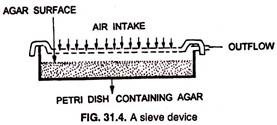The following points highlight the top three devices used for the removal of microorganisms from air. The devices are: 1. Settling Plate 2. Sieve Device 3. Modern Samplers.
Device # 1. Settling Plate:
A Petri dish containing agar medium is kept covered and, at the time of sampling, the cover is removed from the Petri dish so that the agar surface is exposed to air for a few minutes. The Petri dish is now incubated. One can see a certain number of colonies developing on agar medium.
Each colony represents a particle carrying microorganisms which has fallen on the agar surface. Since only particles of certain dimensions tend to settle on to the agar surface and, also, the volume of air entering inside the Petri dish is not known, this technique gives only a rough estimate and can be used only to isolate air-borne microorganisms.
However, one can gather information about the kind of air-borne microbes occurring in a particular area by repeated use of settling plate technique for a fixed period of time.
Device # 2. Sieve Device:
This device (Fig. 31.4) consists of a large number of evenly spaced small holes in a metal cover under which is placed a Petri dish containing agar medium. A measured volume of air is drawn through these hole and the particles containing micro-organisms settle on to the agar surface. The plates are now incubated and microbial colonies are observed on agar surface.
Device # 3. Modern Samplers:
Some modern samplers are the following:
(i) Slit Sampler:
This is a special apparatus (Fig. 31.5) used for air sampling. A known volume of air is directed on to a medium containing plate through a slit of 0.25 nm wide, while the plate is mechanically rotated so that microorganisms are evenly deposited over it.
One cubic foot of air per minute is allowed to pass through the slit. These air samplers are used in examining the amount of microbial contamination in the indoor environments of hospitals, schools, industrial complexes, etc. in order to determine any changes that may occur in their number in the sample.
The efficiency of any disinfection measure taken or ventilation method adapted can also be tested using these samplers. Tests have shown the slit samplers to be highly efficient in recovering air-borne microbial contents, particularly all the bacteria carrying particles passing through the slit get settled on to the agar medium.
(ii) Tilak Sampler:
This sampler (Fig. 31.6) has been designed by Tilak and Kulkarni in 1970 by modifying Panzer’s ‘Slide Spore Collector’. The sampler runs on electric power supply (AC-220 V) and results in a continuous air sampling for 8 days.
The air is sucked through a projecting tube at the rate of 5 liters/minute and passes through a transparent cellotape (1.5 cm in breadth) which is stuck on the slowly rotating drum. The drum completes one circle in 8 days and hence provides the trace of microbial catches within 8 days.
(iii) Aircraft Sampling:
Aircrafts furnished with sticky microscope slide or Petri dish are used for the study of vertical microbe profiles of the lower atmosphere. This method has been considered the simplest and widely used method for collecting aerosol particles.
In this technique, high-speed-aircrafts have been found of considerable advantage over slow-speed- aircrafts. It is because of the fact, which has been experimentally proved, that there exists a strong relation between aircraft speed, width of trapping device used and particle trapping efficiency.


